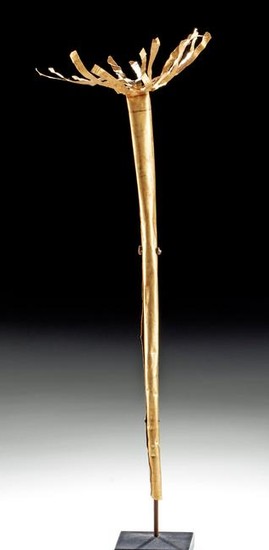Greco-Phoenician Hellenistic 22K+ Gold Votive Fly Whisk
Ancient Eastern Mediterranean, Greco-Phoenician to Hellenistic period, ca. 5th to 3rd century BCE. A stunning votive fly whisk formed from a sheet of 93% gold (equivalent to 22K+). The fly whisk has a tapered tubular body, a broad shoulder, and a thick rim from which fourteen thin strips radiate. Other examples of fly whisks bear thin end tassels or structural wooden rods placed inside the tubular body. The practice of placing ornamental fly whisks in tombs is one that was perpetuated throughout the ancient world from Egypt to Greece and Phoenicia. Flies were thought by the ancients to be some of the most persistent and irritating creatures the gods had ever created; fly whisks were a means of ridding oneself of the problem, if only temporarily. In death, votive fly whisks were meant as a gesture of respect so that, even in death, the deceased would not be perturbed by the airborne annoyances. Size: 3.5" W x 9.3" H (8.9 cm x 23.6 cm); 10.8" H (27.4 cm) on included custom stand; quality of gold: 93% (equivalent to 22K+); total weight: 19.5 grams.
Provenance: private East Coast, USA collection; ex-Madame Frances Artuner collection, Brussels, Belgium, acquired in the 1960s
All items legal to buy/sell under U.S. Statute covering cultural patrimony Code 2600, CHAPTER 14, and are guaranteed to be as described or your money back.
A Certificate of Authenticity will accompany all winning bids.
We ship worldwide to most countries and handle all shipping in-house for your convenience.
#152840 Dimensions: Condition Report: Slight bending and indentations to rod body, rim, and radiating strips, with minor abrasions, and light encrustations within body, otherwise intact and excellent. Great patina throughout.
View it on
Estimate
Time, Location
Auction House
Ancient Eastern Mediterranean, Greco-Phoenician to Hellenistic period, ca. 5th to 3rd century BCE. A stunning votive fly whisk formed from a sheet of 93% gold (equivalent to 22K+). The fly whisk has a tapered tubular body, a broad shoulder, and a thick rim from which fourteen thin strips radiate. Other examples of fly whisks bear thin end tassels or structural wooden rods placed inside the tubular body. The practice of placing ornamental fly whisks in tombs is one that was perpetuated throughout the ancient world from Egypt to Greece and Phoenicia. Flies were thought by the ancients to be some of the most persistent and irritating creatures the gods had ever created; fly whisks were a means of ridding oneself of the problem, if only temporarily. In death, votive fly whisks were meant as a gesture of respect so that, even in death, the deceased would not be perturbed by the airborne annoyances. Size: 3.5" W x 9.3" H (8.9 cm x 23.6 cm); 10.8" H (27.4 cm) on included custom stand; quality of gold: 93% (equivalent to 22K+); total weight: 19.5 grams.
Provenance: private East Coast, USA collection; ex-Madame Frances Artuner collection, Brussels, Belgium, acquired in the 1960s
All items legal to buy/sell under U.S. Statute covering cultural patrimony Code 2600, CHAPTER 14, and are guaranteed to be as described or your money back.
A Certificate of Authenticity will accompany all winning bids.
We ship worldwide to most countries and handle all shipping in-house for your convenience.
#152840 Dimensions: Condition Report: Slight bending and indentations to rod body, rim, and radiating strips, with minor abrasions, and light encrustations within body, otherwise intact and excellent. Great patina throughout.



